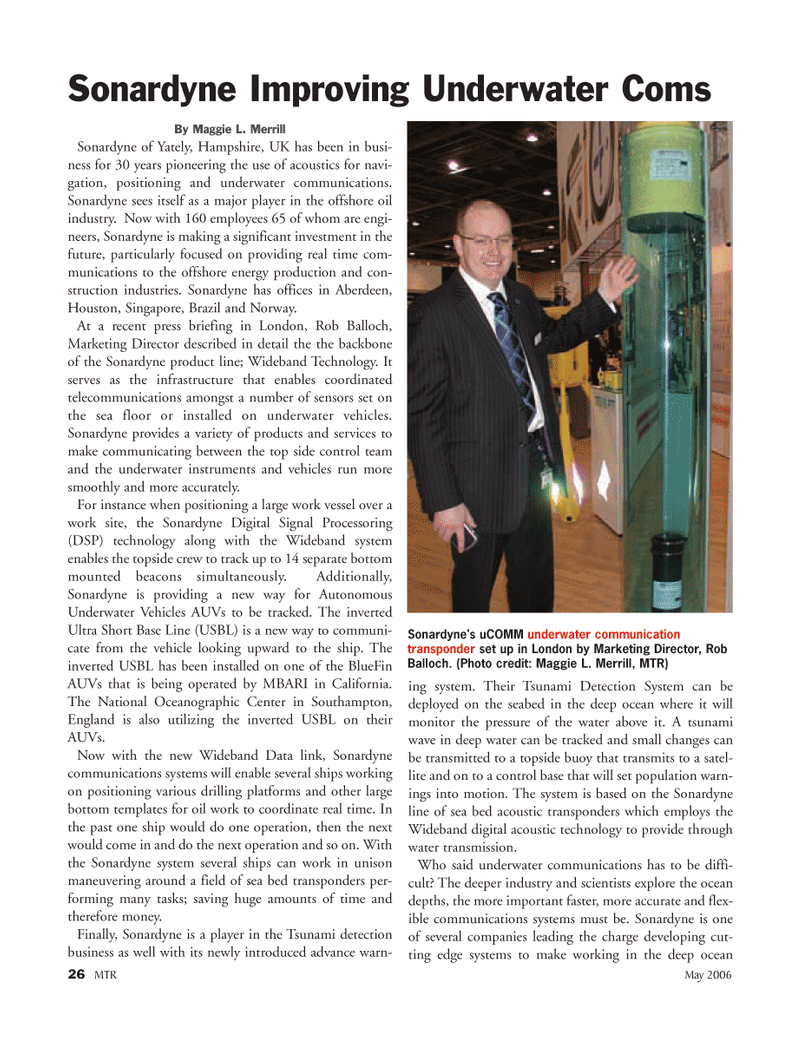
Page 26: of Marine Technology Magazine (May 2006)
The Communications Edition
Read this page in Pdf, Flash or Html5 edition of May 2006 Marine Technology Magazine
By Maggie L. Merrill
Sonardyne of Yately, Hampshire, UK has been in busi- ness for 30 years pioneering the use of acoustics for navi- gation, positioning and underwater communications.
Sonardyne sees itself as a major player in the offshore oil industry. Now with 160 employees 65 of whom are engi- neers, Sonardyne is making a significant investment in the future, particularly focused on providing real time com- munications to the offshore energy production and con- struction industries. Sonardyne has offices in Aberdeen,
Houston, Singapore, Brazil and Norway.
At a recent press briefing in London, Rob Balloch,
Marketing Director described in detail the the backbone of the Sonardyne product line; Wideband Technology. It serves as the infrastructure that enables coordinated telecommunications amongst a number of sensors set on the sea floor or installed on underwater vehicles.
Sonardyne provides a variety of products and services to make communicating between the top side control team and the underwater instruments and vehicles run more smoothly and more accurately.
For instance when positioning a large work vessel over a work site, the Sonardyne Digital Signal Processoring (DSP) technology along with the Wideband system enables the topside crew to track up to 14 separate bottom mounted beacons simultaneously. Additionally,
Sonardyne is providing a new way for Autonomous
Underwater Vehicles AUVs to be tracked. The inverted
Ultra Short Base Line (USBL) is a new way to communi- cate from the vehicle looking upward to the ship. The inverted USBL has been installed on one of the BlueFin
AUVs that is being operated by MBARI in California.
The National Oceanographic Center in Southampton,
England is also utilizing the inverted USBL on their
AUVs.
Now with the new Wideband Data link, Sonardyne communications systems will enable several ships working on positioning various drilling platforms and other large bottom templates for oil work to coordinate real time. In the past one ship would do one operation, then the next would come in and do the next operation and so on. With the Sonardyne system several ships can work in unison maneuvering around a field of sea bed transponders per- forming many tasks; saving huge amounts of time and therefore money.
Finally, Sonardyne is a player in the Tsunami detection business as well with its newly introduced advance warn- ing system. Their Tsunami Detection System can be deployed on the seabed in the deep ocean where it will monitor the pressure of the water above it. A tsunami wave in deep water can be tracked and small changes can be transmitted to a topside buoy that transmits to a satel- lite and on to a control base that will set population warn- ings into motion. The system is based on the Sonardyne line of sea bed acoustic transponders which employs the
Wideband digital acoustic technology to provide through water transmission.
Who said underwater communications has to be diffi- cult? The deeper industry and scientists explore the ocean depths, the more important faster, more accurate and flex- ible communications systems must be. Sonardyne is one of several companies leading the charge developing cut- ting edge systems to make working in the deep ocean 26 MTR May 2006
Sonardyne Improving Underwater Coms
Sonardyne's uCOMM underwater communication transponder set up in London by Marketing Director, Rob
Balloch. (Photo credit: Maggie L. Merrill, MTR)
MTR#4 (17-32).qxd 5/8/2006 9:55 AM Page 26

 25
25

 27
27
